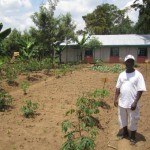Source which includes videos: Chad Lipton, The Great Energy Challenge, Aug 21, 2012
Fueling Agricultural Change in Western Kenya
In recent years, the people of western Kenya have been feeling the painful effects of climate change and deforestation. As the practice of chopping down trees for fuel wood continued, “deforestation was getting worse,” says resident Salim Shaban. Removing trees compromises nutrient and water retention in soils, and nutrients lost in the runoff can pollute valuable freshwater lakes and rivers.

ACON is testing plots to see how crops grown with biochar fare, versus those grown without. Biochar creates a significant benefit. (Photograph by Chad Lipton)
To make matters worse, the rainy seasons have been coming later in the year, shortening the growing season. Most farmers in Kenya live hand to mouth, and were having trouble feeding their families.
Frustrated by increasingly meager harvests, Salim vowed to take action. Convinced that environmental problems were compromising soil integrity, “I decided to figure out what was needed to improve the environment,” he says.
Salim had founded the African Christians Organization Network (ACON) 12 years ago, and in 2008, he reached out to the International Biochar Initiative for guidance on improving soil fertility. This developed into a meaningful relationship and the creation of a biochar stove.
That relationship led to the pioneering of Africa’s first biochar initiative, building a network of 6,000 farmers in 50 communities who are learning to use biochar stoves to boost organic farming, reduce indoor air pollution and sequester carbon from the atmosphere.
The biochar stove is principally sold as an improved cooking device: It uses less fuel wood, cooks food faster and creates less smoke than a traditional three-stone stove. Although calculations vary, Salim estimates that families save enough on fuel wood to pay for the stove in three to six months.
When the cooking process is complete, the charred fuel wood becomes a valuable soil enhancer. A women’s group based in Ikolomani reported that the stove’s biochar has greatly increased their yields of maize, beans, and tea. During my recent visit to the village, eleven women farmers were eager to show off their crops. One woman boasted, “Before using biochar, I did not have enough food to feed my family. Now, I have enough for everyone and can sell extra food to pay school fees (for my son) and buy a cow.”
ACON recently started making biomass fuel briquettes as an alternative to fuel wood. The production of fuel briquettes is very popular, and fewer briquettes than fuel wood are needed to cook food. The briquettes are made of biological waste such as maize stalks or water hyacinth.
“Unfortunately, there is an endless supply (of hyacinth),” Salim laments. Several years ago, water hyacinth was accidentally introduced into Lake Victoria, where it immediately began multiplying and greatly disrupted the local economy, which depends upon fishing. ACON responded to this environmental problem by removing the hyacinth from Lake Victoria to make fuel briquettes. Even so, the water hyacinth still multiplies much more quickly than ACON can remove it.
For each biochar stove sold, ACON gives 20 tree seedlings to farmers to plant. “We need to reduce climate change. That is why we provide tree seedlings,” says Salim.
Climate change is global, but solutions are local. Salim’s investment in his local community is paying off and he is eager to spread the word. Next week, more than a dozen Ugandan farmers are traveling to Western Kenya to meet Salim and learn about his biochar project with ACON.
When asked if there were any complaints with the biochar program, one farmer responded, “Actually, I do have one complaint. I have more than one wife, but only one stove. They fight over it.”
* African Christians Organization Network is a grant recipient of the National Geographic’s Great Energy Challenge initiative.



